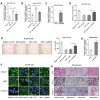Angelica Sinensis Polysaccharide Suppresses Epithelial-Mesenchymal Transition and Pulmonary Fibrosis via a DANCR/AUF-1/FOXO3 Regulatory Axis
- PMID: 32010478
- PMCID: PMC6961774
- DOI: 10.14336/AD.2019.0512
Angelica Sinensis Polysaccharide Suppresses Epithelial-Mesenchymal Transition and Pulmonary Fibrosis via a DANCR/AUF-1/FOXO3 Regulatory Axis
Abstract
Idiopathic pulmonary fibrosis (IPF) is characterized by the accumulation of lung fibroblasts and extracellular matrix deposition. Angelica sinensis polysaccharide (ASP), the major bioactive component that can extracted from roots of angelica, plays functional roles in immunomodulation, anti-tumor activity, and hematopoiesis. Emerging evidence has suggested that long noncoding RNAs (lncRNAs) play important roles in pathophysiological processes in various diseases. However, the roles of lncRNAs and ASP in IPF remain poorly understood. In the present study, we investigated the effects of ASP in IPF, as well as their functional interactions with lncRNA DANCR (differentiation antagonizing non-protein coding RNA). IPF models were established by treating Sprague-Dawley rats with BLM and treating alveolar type Ⅱ epithelial (RLE-6TN) cells with TGF-β1. Our results showed that ASP treatment suppressed pulmonary fibrosis in rats and fibrogenesis in RLE-6TN cells. The lncRNA DANCR is downregulated after ASP treatment in both rat lung tissues and RLE-6TN cells, and DANCR overexpression dramatically reversed the suppressive effects of ASP in IPF. Mechanistically, DANCR directly binds with AUF1 (AU-binding factor 1), thereby upregulating FOXO3 mRNA and protein levels. Moreover, overexpression of AUF1 or FOXO3 reversed the functional effects induced by ASP treatment. In conclusion, our findings showed that DANCR mediates ASP-induced suppression of IPF via upregulation of FOXO3 protein levels in an AUF1-dependent manner. Therefore, DANCR could serve as a promising therapeutic target in IPF treatment with ASP.
Keywords: AUF1; DANCR; FOXO3; angelica sinensis polysaccharide; idiopathic pulmonary fibrosis.
Copyright: © 2019 Qian et al.
Figures







Similar articles
-
Long noncoding RNA DANCR is activated by SALL4 and promotes the proliferation and invasion of gastric cancer cells.Oncotarget. 2017 Dec 6;9(2):1915-1930. doi: 10.18632/oncotarget.23019. eCollection 2018 Jan 5. Oncotarget. 2017. PMID: 29416741 Free PMC article.
-
DA-Raf-Mediated Suppression of the Ras--ERK Pathway Is Essential for TGF-β1-Induced Epithelial-Mesenchymal Transition in Alveolar Epithelial Type 2 Cells.PLoS One. 2015 May 21;10(5):e0127888. doi: 10.1371/journal.pone.0127888. eCollection 2015. PLoS One. 2015. PMID: 25996975 Free PMC article.
-
Integrated long non-coding RNA analyses identify novel regulators of epithelial-mesenchymal transition in the mouse model of pulmonary fibrosis.J Cell Mol Med. 2016 Jul;20(7):1234-46. doi: 10.1111/jcmm.12783. Epub 2016 Jan 29. J Cell Mol Med. 2016. PMID: 26824344 Free PMC article.
-
Emerging role of lncRNA DANCR in progenitor cells: beyond cancer.Eur Rev Med Pharmacol Sci. 2021 Feb;25(3):1399-1409. doi: 10.26355/eurrev_202102_24848. Eur Rev Med Pharmacol Sci. 2021. PMID: 33629310 Review.
-
Long Non-coding RNA DANCR as an Emerging Therapeutic Target in Human Cancers.Front Oncol. 2019 Nov 15;9:1225. doi: 10.3389/fonc.2019.01225. eCollection 2019. Front Oncol. 2019. PMID: 31799189 Free PMC article. Review.
Cited by
-
Effects of PAMK on lncRNA, miRNA, and mRNA expression profiles of thymic epithelial cells.Funct Integr Genomics. 2022 Oct;22(5):849-863. doi: 10.1007/s10142-022-00863-7. Epub 2022 May 4. Funct Integr Genomics. 2022. PMID: 35505120
-
Analysis of the Clinical Efficacy and Molecular Mechanism of Xuefu Zhuyu Decoction in the Treatment of COPD Based on Meta-Analysis and Network Pharmacology.Comput Math Methods Med. 2022 Nov 26;2022:2615580. doi: 10.1155/2022/2615580. eCollection 2022. Comput Math Methods Med. 2022. PMID: 36479314 Free PMC article.
-
Role of Danggui Buxue Decoction for the prevention and treatment of cardiovascular and pulmonary diseases.Zhong Nan Da Xue Xue Bao Yi Xue Ban. 2023 Oct 28;48(10):1479-1493. doi: 10.11817/j.issn.1672-7347.2023.230198. Zhong Nan Da Xue Xue Bao Yi Xue Ban. 2023. PMID: 38432878 Free PMC article. Chinese, English.
-
Qing Fei Hua Xian Decoction ameliorates bleomycin-induced pulmonary fibrosis by suppressing oxidative stress through balancing ACE-AngII-AT1R/ACE2-Ang-(1-7)-Mas axis.Iran J Basic Med Sci. 2023 Jan;26(1):107-113. doi: 10.22038/IJBMS.2022.67042.14700. Iran J Basic Med Sci. 2023. PMID: 36594067 Free PMC article.
-
Angelica sinensis polysaccharide (ASP) attenuates diosbulbin-B (DB)-induced hepatotoxicity through activating the MEK/ERK pathway.Bioengineered. 2021 Dec;12(1):3516-3524. doi: 10.1080/21655979.2021.1950280. Bioengineered. 2021. PMID: 34229534 Free PMC article.
References
-
- Jacob J, Bartholmai BJ, Rajagopalan S, Karwoski R, Nair A, Walsh SLF, et al. (2018). Likelihood of pulmonary hypertension in patients with idiopathic pulmonary fibrosis and emphysema. Respirology, 23:593-599. - PubMed
-
- Diaz-Pina G, Ordonez-Razo RM, Montes E, Paramo I, Becerril C, Salgado A, et al. (2018). The Role of ADAR1 and ADAR2 in the Regulation of miRNA-21 in Idiopathic Pulmonary Fibrosis. Lung, 196:393-400. - PubMed
-
- Wei WL, Zeng R, Gu CM, Qu Y, Huang LF (2016). Angelica sinensis in China-A review of botanical profile, ethnopharmacology, phytochemistry and chemical analysis. J Ethnopharmacol, 190:116-141. - PubMed
-
- Jin M, Zhao K, Huang Q, Xu C, Shang P (2012). Isolation, structure and bioactivities of the polysaccharides from Angelica sinensis (Oliv.) Diels: a review. Carbohydr Polym, 89:713-722. - PubMed
LinkOut - more resources
Full Text Sources
Research Materials
